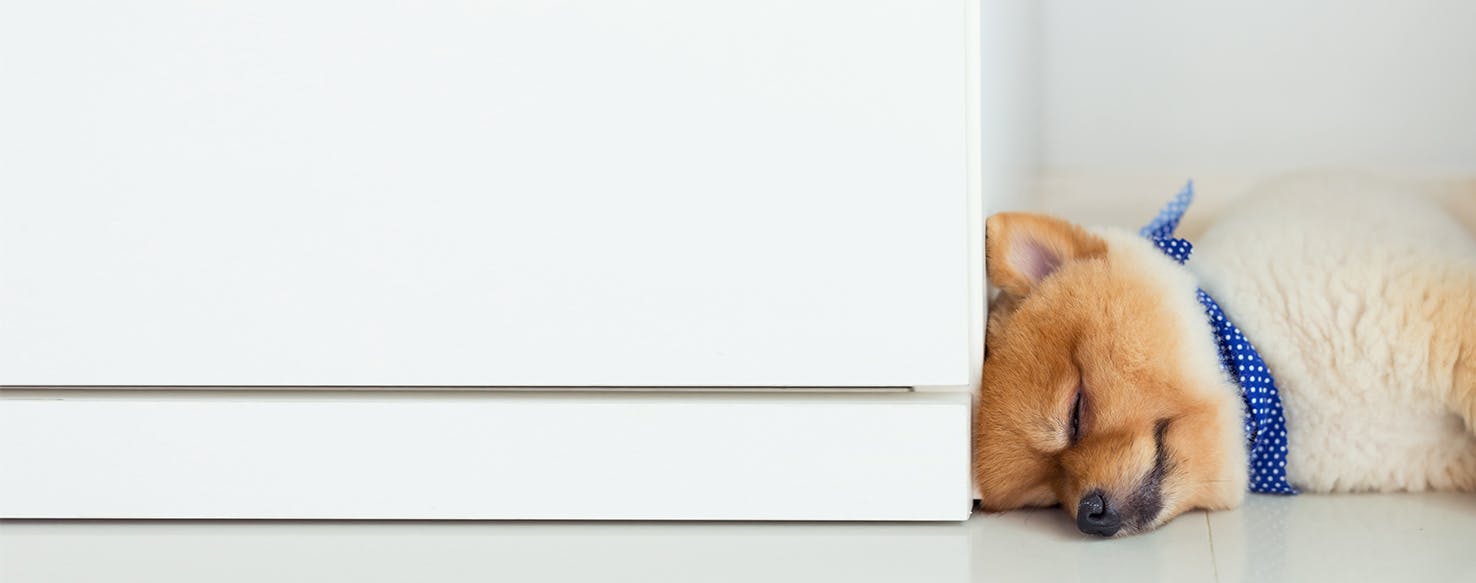- Home
- The Daily Wag!
- Behavior
- Why Do Dogs Make Noise In Their Sleep

Common
Normal
There is little else in the world as sweet or adorable as a sleeping dog. Dogs sleep quite a lot, so you may have ample opportunity to observe your pet at rest. But you may have noticed that your sleeping dog might not look like they’re sleeping very well. There is an abundance of videos out on the Internet depicting sleeping dogs making a variety of movements and sounds. Including some dogs who even sleepwalk. If your dog has ever yipped, barked, whined, snored, or howled in their sleep, you might be wondering why. Why do dogs make noise in their sleep, and what does it mean?
All animals sleep. Some sleep more than others. Dogs spend around half of their day sleeping, around 30 percent resting or lying down, and only about 20 percent active. But your dog may sleep more or less, depending on their age, breed, health, and even their personality. Some dogs are completely happy just snoozing on your lap or by your side all day long and any dog can be a lazy or playful dog. Puppies and elderly dogs tend to sleep more than adults, up to 18 and 20 hours per day. Puppies tend to exhaust themselves quickly through play and other activity. Older dogs just become tired more quickly and need more rest to recover. Dogs sleep very similarly to humans. They enter REM sleep just like we do. REM, or rapid eye movement, is a phase of sleep where eyes roll frequently behind their eyelids and they may react during sleep. This is the level of sleep when humans and dogs dream. Humans may spend up to 25 percent of their sleep in REM, but dogs only spend around 10 percent there, since they’re more prone to waking suddenly and being immediately alert. They may need more sleep overall to make up for fewer REM cycles. Some dogs may dream more often than others. Small dogs, for example, tend to dream more often than larger dogs, up to a new dream every 10 minutes, whereas large dogs might only dream once in 90 minutes. Since dogs experience the same REM sleep as humans do, the consensus is that dogs probably dream similarly to humans. There’s no way to tell what they could be dreaming about, but their reactions and body movements during their dreams might be an indicator what it’s about. It’s most likely about recent events or memories. Jerking their paws and yipping could indicate an exciting chase of some critter or a favorite toy. Other strange noises might be similar to humans talking in their sleep; just a noise related to whatever it is they’re dreaming about. Whining or crying in their sleep may even indicate a bad dream or nightmare.
Need advice about your pet's health?
Get answers fast from a veterinary professional 24/7 in the Wag! App.
Get Vet ChatDog’s brains are actually very similar to human brains. While
there may not be conclusive evidence to prove with 100 percent certainty, it’s
highly probable that dog’s dream similarly to humans. So all those strange
twitches, yips, and other noises are normal and natural. If your dog is making bizarre noises in their sleep, they’re
just fine. But you should make sure your dog is actually asleep. Puppies
especially may whine to get your attention because they need to go potty or may
be uncomfortable in some way. Crate training, especially, might evoke some
whining when the pup is lonely or bored. Illness might also cause your dog to
whine for attention. If your dog is exhibiting any other symptoms or you’re
concerned, contact your vet. Some dogs are also more prone to snoring than others, but
any dog can snore. Snoring is another normal nighttime noise for dogs. Dogs
with “smooshed” faces like Pugs or Bulldogs may be more likely to snore than
others. If your dog is making strange sounds in their sleep, try
not to disturb them. Even if you think your dog may be having a nightmare, you
may want to just leave them be. Dogs need uninterrupted sleep to be fully
rested. Also, a dog who is tense may not appreciate being startled awake. Do
not touch your dog when they’re tense in sleep because they may react instinctively
and defensively. They may even bite your hand, not realizing you’re not a
threat. If you do feel like you need to wake them from a nightmare, just call
their name from a safe distance.
Some dogs might appear to sleep with their eyes partially or even fully open during REM sleep. What they look like with partially open lids might send you to the nearest veterinarian (or exorcist), but rest assured, REM sleep is totally normal and a natural part of sleep. Be aware, however, of the difference between a dog in REM sleep and a dog having a seizure. Dogs might twitch their paws or legs during sleep, but twitching shouldn’t be consistent or constant. Your dog will also snap out of REM sleep and be alert if you call their name. A dog having a seizure will also appear stiff, pant excessively, drool or froth at the mouth, and will not respond to their name being called. If you suspect your dog has had seizures, talk to your vet.
Your dog may sleep a little or a lot, curled up or stretched out,
noisily or silently, on the bed or on the floor. It is all natural and an
essential part of a dog’s health and well-being. However they sleep, it is generally
best to leave them be. Or, as the old saying goes, “Let sleeping dogs lie.”
Written by a Border Collie lover Charlotte Perez
Veterinary reviewed by:
Published: 02/21/2018, edited: 01/30/2020
More articles by Charlotte Perez

